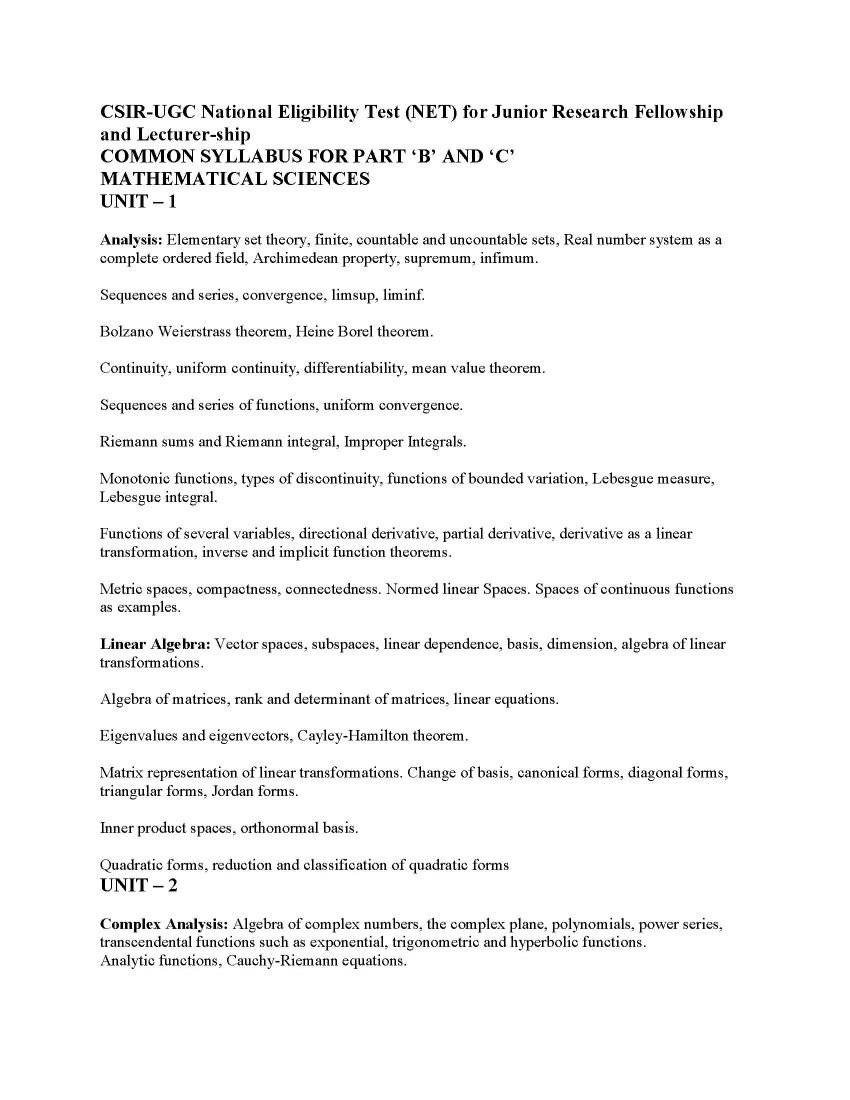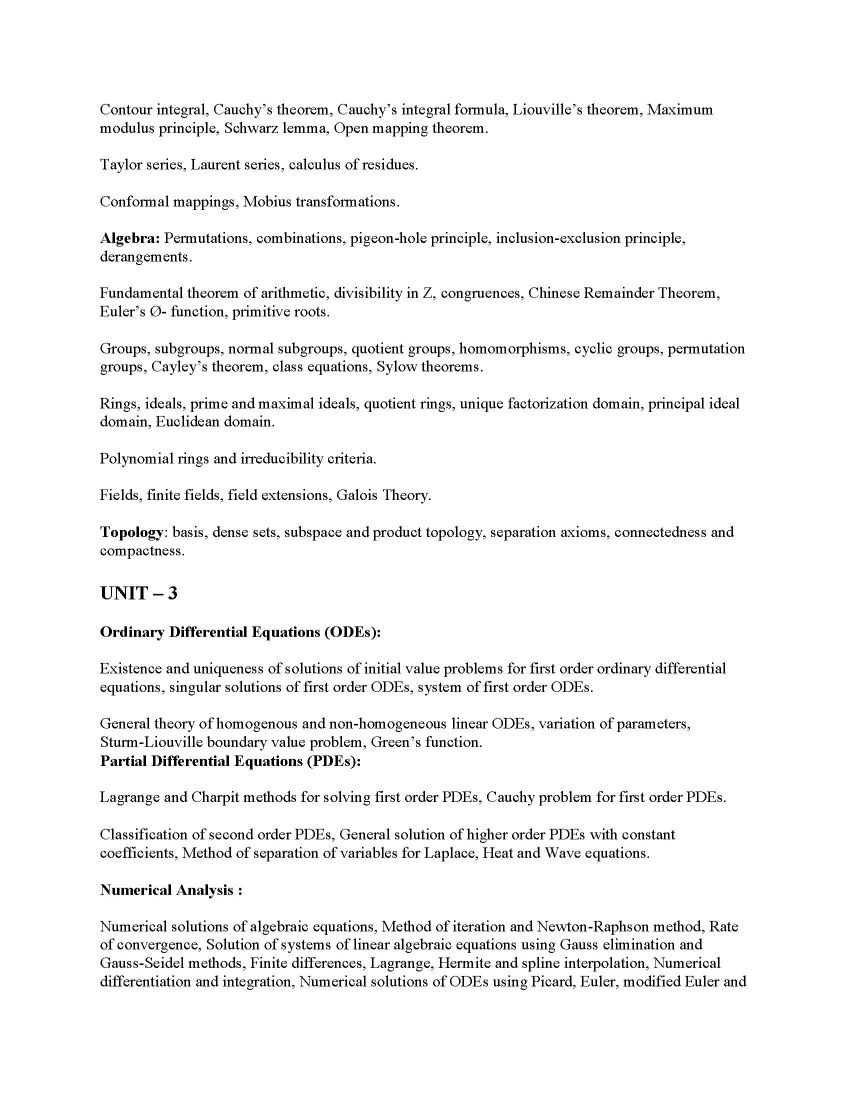| Re: CSIR UGC NET (Mathematical Science) syllabus
CSIR UGC NET stands for Council of Scientific and Industrial Research Human Resource Development Group Examination Unit. University Grants Commission conducts the National Eligibility Test (NET) every year for candidates from all over India to apply for lectureship as well as Junior Research Fellowship Program.
Paper pattern:
CSIR-UGC (NET) Exam for Award of Junior Research Fellowship and Eligibility for Lectureship shall be a Single Paper Test having Multiple Choice Questions (MCQs). The question paper shall be divided in three parts.
Part 'A'
This part shall carry 20 questions pertaining to General Science, Quantitative Reasoning & Analysis and Research Aptitude. The candidates shall be required to answer any 15 questions. Each question shall be of two marks. The total marks allocated to this section shall be 30 out of 200.
Part 'B'
This part shall contain 40 Multiple Choice Questions (MCQs) generally covering the topics given in the syllabus. A candidate shall be required to answer any 25 questions. Each question shall be of three marks. The total marks allocated to this section shall be 75 out of 200.
Part 'C'
This part shall contain 60 questions that are designed to test a candidate's knowledge of scientific concepts and/or application of the scientific concepts. The questions shall be of analytical nature where a candidate is expected to apply the scientific knowledge to arrive at the solution to the given scientific problem. The questions in this part shall have multiple correct options. Credit in a question shall be given only on identification of ALL the correct options. No credit shall be allowed in a question if any incorrect option is marked as correct answer. No partial credit is allowed. A candidate shall be required to answer any 20 questions. Each question shall be of 4.75 marks. The total marks allocated to this section shall be 95 out of 200.
For Part ‘A’ and ‘B’ there will be Negative marking @25% for each wrong answer. No Negative marking for Part ‘C’.
CSIR UGC NET (Mathematical Science) syllabus
UNIT – 1
Analysis: Elementary set theory, finite, countable and uncountable sets, Real number system as a complete ordered field, Archimedean property, supremum, infimum.
Sequences and series, convergence, limsup, liminf.
Bolzano Weierstrass theorem, Heine Borel theorem.
Continuity, uniform continuity, differentiability, mean value theorem.
Sequences and series of functions, uniform convergence.
Riemann sums and Riemann integral, Improper Integrals.
Monotonic functions, types of discontinuity, functions of bounded variation, Lebesgue measure, Lebesgue integral.
Functions of several variables, directional derivative, partial derivative, derivative as a linear transformation.
Metric spaces, compactness, connectedness. Normed Linear Spaces. Spaces of Continuous functions as examples.
Linear Algebra: Vector spaces, subspaces, linear dependence, basis, dimension, algebra of linear transformations.
Algebra of matrices, rank and determinant of matrices, linear equations.
Eigenvalues and eigenvectors, Cayley-Hamilton theorem.
Matrix representation of linear transformations. Change of basis, canonical forms, diagonal forms, triangular forms, Jordan forms.
Inner product spaces, orthonormal basis.
Quadratic forms, reduction and classification of quadratic forms.
UNIT – 2
Complex Analysis: Algebra of complex numbers, the complex plane, polynomials, Power series, transcendental functions such as exponential, trigonometric and hyperbolic functions.
Analytic functions, Cauchy-Riemann equations.
Contour integral, Cauchy’s theorem, Cauchy’s integral formula, Liouville’s theorem, Maximum modulus principle, Schwarz lemma, Open mapping theorem.
Taylor series, Laurent series, calculus of residues.
Conformal mappings, Mobius transformations.
Algebra: Permutations, combinations, pigeon-hole principle, inclusion-exclusion principle, derangements.
Fundamental theorem of arithmetic, divisibility in Z, congruences, Chinese Remainder Theorem, Euler’s Ø- function, primitive roots.
Groups, subgroups, normal subgroups, quotient groups, homomorphisms,
cyclic groups, permutation groups, Cayley’s theorem, class equations, Sylow theorems.
Rings, ideals, prime and maximal ideals, quotient rings, unique factorization domain, principal ideal domain, Euclidean domain.
Polynomial rings and irreducibility criteria.
Fields, finite fields, field extensions.
UNIT – 3
Ordinary Differential Equations (ODEs):
Existence and Uniqueness of solutions of initial value problems for first order ordinary differential equations, singular solutions of first order ODEs, system of first order ODEs.
General theory of homogenous and non-homogeneous linear ODEs, variation of parameters, Sturm-Liouville boundary value problem, Green’s function.
Partial Differential Equations (PDEs):
Lagrange and Charpit methods for solving first order PDEs, Cauchy problem for first order PDEs.
Classification of second order PDEs, General solution of higher order PDEs with constant coefficients, Method of separation of variables for Laplace, Heat and Wave equations.
Numerical Analysis :
Numerical solutions of algebraic equations, Method of iteration and Newton-Raphson method, Rate of convergence, Solution of systems of linear algebraic equations using Gauss elimination and Gauss-Seidel methods, Finite differences, Lagrange, Hermite and spline interpolation, Numerical differentiation and integration, Numerical solutions of ODEs using Picard, Euler, modified Euler and Runge-Kutta methods.
Calculus of Variations:
Variation of a functional, Euler-Lagrange equation, Necessary and sufficient conditions for extrema. Variational methods for boundary value problems in ordinary and partial differential equations.
Linear Integral Equations:
Linear integral equation of the first and second kind of Fredholm and Volterra type, Solutions with separable kernels. Characteristic numbers and eigenfunctions, resolvent kernel.
Classical Mechanics:
Generalized coordinates, Lagrange’s equations, Hamilton’s canonical equations, Hamilton’s principle and principle of least action, Two-dimensional motion of rigid bodies, Euler’s dynamical equations for the motion of a rigid body about an axis, theory of small oscillations.
UNIT – 4
Descriptive statistics, exploratory data analysis.
Sample space, discrete probability, independent events, Bayes theorem. Random variables and distribution functions (univariate and multivariate); expectation and moments. Independent random variables, marginal and conditional distributions. Characteristic functions. Probability inequalities (Tchebyshef, Markov, Jensen). Modes of convergence, weak and strong laws of large numbers, Central Limit theorems (i.i.d. case).
Markov chains with finite and countable state space, classification of states, limiting behaviour of n-step transition probabilities, stationary distribution.
Standard discrete and continuous univariate distributions. Sampling distributions. Standard errors and asymptotic distributions, distribution of order statistics and range.
Methods of estimation. Properties of estimators. Confidence intervals. Tests of hypotheses: most powerful and uniformly most powerful tests, Likelihood ratio tests. Analysis of discrete data and chi-square test of goodness of fit. Large sample tests.
Simple nonparametric tests for one and two sample problems, rank correlation and test for independence. Elementary Bayesian inference.
Gauss-Markov models, estimability of parameters, Best linear unbiased estimators, tests for linear hypotheses and confidence intervals. Analysis of variance and covariance. Fixed, random and mixed effects models. Simple and multiple linear regression. Elementary regression diagnostics. Logistic regression.
Multivariate normal distribution, Wishart distribution and their properties. Distribution of quadratic forms. Inference for parameters, partial and multiple correlation coefficients and related tests. Data reduction techniques: Principle component analysis, Discriminant analysis, Cluster analysis, Canonical correlation.
Simple random sampling, stratified sampling and systematic sampling. Probability proportional to size sampling. Ratio and regression methods.
Completely randomized, randomized blocks and Latin-square designs. Connected, complete and orthogonal block designs, BIBD. 2K factorial experiments: confounding and construction.
Series and parallel systems, hazard function and failure rates, censoring and life
testing.
Linear programming problem. Simplex methods, duality. Elementary queuing and inventory models. Steady-state solutions of Markovian queuing models: M/M/1, M/M/1 with limited waiting space, M/M/C, M/M/C with limited waiting space, M/G/1.
|



